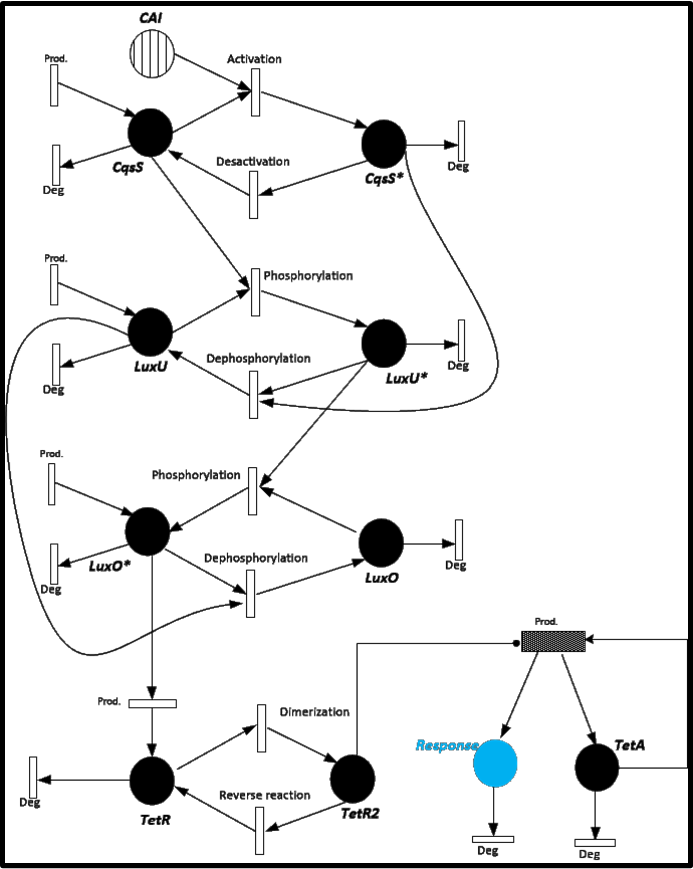Team:Colombia/Stochastic
From 2014.igem.org
| Line 14: | Line 14: | ||
Until now, all we have is a deterministic model of our system of detection of Cholerae. This model takes into account exact concentrations of molecules as variables in the differential equations. This means that we make calculations with the mean values of the amount of molecules. | Until now, all we have is a deterministic model of our system of detection of Cholerae. This model takes into account exact concentrations of molecules as variables in the differential equations. This means that we make calculations with the mean values of the amount of molecules. | ||
It’s well known that we can simulate this kind of molecular dynamics as stochastic processes. In particular, such an events will we simulated as Markovian random walk in N dimension, where N represents the number of substances involved. | It’s well known that we can simulate this kind of molecular dynamics as stochastic processes. In particular, such an events will we simulated as Markovian random walk in N dimension, where N represents the number of substances involved. | ||
| - | |||
| - | |||
| - | |||
<i> | <i> | ||
| Line 22: | Line 19: | ||
</i> | </i> | ||
| + | |||
| + | |||
| + | |||
| + | [[File:Colombia_PetriNet.png|center|600px]] | ||
| + | |||
| + | Dealing with such a processes, the first possible approach will be to solve the stochastic master equation. The function that satisfies that equation will measure the probability of finding different numbers of molecules of the N different substances at each instant of time. But as you should probably know, this kind of numerical computation will be hard to develop and won’t be efficient. One of the reason is, for example, that, due to the very low probability of occurrence of the events (chemical reactions, ARN transcription, proteins production, …), and the very short time intervals we should use, most of the time won’t be happening nothing. | ||
| + | |||
| + | For that reason, we decided to use a nice very efficient algorithm proposed by Daniel Gillespie, which is based in a different probability function density: The reaction probability density function. These functions will tell us how much time will pass until the next event occurrence and how this time is distributed. After that we decided which one of the events will occur based on the number of molecules of each species and how they interact with each other. | ||
| + | |||
| + | To give you an idea of how does our system works and how will be the events related, we present a Stochastic Petri Net. In Figure 1 we can appreciate the different molecules species interacting between them or undergoing process such as degradation or production. | ||
| + | |||
| + | In this case, we have 24 different possible events to take into account. (Table 1) | ||
| + | |||
| + | [[File:Colombia_TableEst.jpg|center|600px]] | ||
Revision as of 21:21, 17 October 2014
Stochastic Model.
Until now, all we have is a deterministic model of our system of detection of Cholerae. This model takes into account exact concentrations of molecules as variables in the differential equations. This means that we make calculations with the mean values of the amount of molecules.
It’s well known that we can simulate this kind of molecular dynamics as stochastic processes. In particular, such an events will we simulated as Markovian random walk in N dimension, where N represents the number of substances involved.
“…For “ordinary” chemical systems in which fluctuations and correlations play no significant role, the method stands as an alternative to the traditional procedure of numerically solving the deterministic reaction rate equations. For nonlinear systems near chemical instabilities, where fluctuations and correlations may invalidate the deterministic equations, the method constitutes an efficient way of numerically examining the predictions of the stochastic master equation. Although fully equivalent to the spatially homogeneous master equation, the numerical…” (Gillespie 1976)
Dealing with such a processes, the first possible approach will be to solve the stochastic master equation. The function that satisfies that equation will measure the probability of finding different numbers of molecules of the N different substances at each instant of time. But as you should probably know, this kind of numerical computation will be hard to develop and won’t be efficient. One of the reason is, for example, that, due to the very low probability of occurrence of the events (chemical reactions, ARN transcription, proteins production, …), and the very short time intervals we should use, most of the time won’t be happening nothing.
For that reason, we decided to use a nice very efficient algorithm proposed by Daniel Gillespie, which is based in a different probability function density: The reaction probability density function. These functions will tell us how much time will pass until the next event occurrence and how this time is distributed. After that we decided which one of the events will occur based on the number of molecules of each species and how they interact with each other.
To give you an idea of how does our system works and how will be the events related, we present a Stochastic Petri Net. In Figure 1 we can appreciate the different molecules species interacting between them or undergoing process such as degradation or production.
In this case, we have 24 different possible events to take into account. (Table 1)
 "
"







